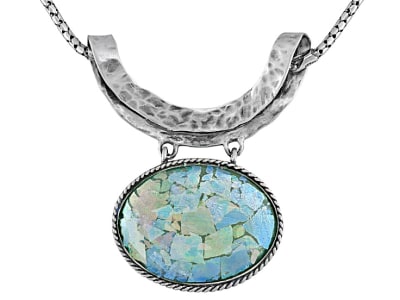Roman Glass is actual glass that has been buried for 2,000-years in mineral-rich soil. Archeological sites located near Jerusalem serve as the main source of Roman glass, notably because Israel once served as a major glass-making center. A thin layer of patina naturally forms on the glass as minerals in the soil react with the glass. The natural process of oxidation creates the various shades of blues and greens on the surface. As the coloration depends on the mineral condition to which the glass is exposed, each piece is unique.
General Information
Common Name
Roman Glass
Species
Glass
Transparency
Opaque-Transparent
Dispersion
Strength: Moderate if Contains Lead Value: 0.009
Refractive Index
Over The Limit 1.470-1.700 Tolerance: Can go OTL
Optic Character
NA
Optic Sign
NA
Polariscope Reaction
Aggregate (AGG), Anomalous Double Refraction (ADR)
Fluorescence
SWUV: Variable
LWUV: Variable
LWUV: Variable
Pleochroism
None
Hardness
5-6
Toughness
Poor
Inclusions
Air bubbles, flow lines
Luster
Vitreous, Subvitreous
Fracture
Conchoidal, Granular, Splintery
Cleavage
None
Chemical Name
Silica
Crystal System
NA
Roman Glass Colors
-
 Bi-color
Bi-color -
 Black
Black -
 Blue
Blue -
 Brown
Brown -
 Colorless
Colorless -
 Gray
Gray -
 Green
Green -
 Multi-color
Multi-color -
 Orange
Orange -
 Pink
Pink -
 Purple
Purple -
 Red
Red -
 White
White
Countries of Origin
Unknown; Italy
